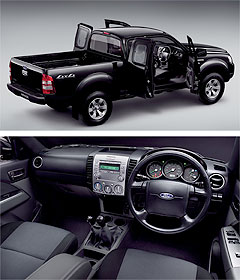Ford Courier to make way for tough new Ranger
BY NEIL MCDONALD | 1st Nov 2006

Compared to the Courier, the Ranger is more powerful, offers increased towing ability but maintains a one-tonne-plus payload across the range.
Like Mazda, whose B-Series Bravo-replacing BT-50 shares the Ranger architecture, Ford has dropped the 154kW/323Nm 4.0-litre V6 engine, opting instead for latest-generation direct-injection common-rail 2.5-litre or 3.0-litre turbo-diesels, called Duratorq in the Fords.
The entry-level 2.5-litre turbo-diesel develops 105kW at 3500rpm and 330Nm at 1800rpm, while the 3.0-litre offers 115kW at 3200rpm and 380Nm 1800rpm.
Ford claims the 16-valve 2.5-litre and 3.0-litre four-cylinder Duratorq engines are quieter but offer better performance, improved fuel economy and lower emissions.
A variable-geometry turbocharger is claimed to significantly reduce turbo lag, broaden the torque curve and promote smoother and faster acceleration.
When compared with the previous Courier model’s 2.5-litre diesel, torque is up 22 per cent at 200 fewer revs and fuel economy has improved 17 per cent in the new 2.5-litre engine.
The 3.0-litre turbo-diesel can be matched to either a five-speed manual or optional five-speed automatic transmission.
The Ranger has a more aggressive and bolder look, a car-like interior, improved ride and handling and significantly higher towing capacity.
At the front there is a large, wide grille with dominant power bulge in the bonnet. Clear-lens reflector headlamps with jewel-like details and a bold split front bumper helping to protect integrated fog lights (where fitted).
At the rear, the sidewall of the cargo box is 50mm higher than the Courier's, lifiting storage to 1266 litres on single-cab models.
Inside, the front seats are now more sculpted and supportive, with larger head restraints.
Switchgear is more intuitive and a redesigned centre console has easier to operate controls.
The console contains new ventilation controls and a standard audio system that features an AM/FM radio and an in-dash CD player with MP3 capability.
Emphasis has also been placed on more convenient storage areas around the cabin. The two-bin centre console can store up to 10 CDs and two mobile phones.
The single-cab, crew-cab, chassis-cab and super-cab incorporate the innovative rear access system (RAS), which combines the two front doors with two rearward opening doors for easier loading and unloading.
The ute's chassis is tougher and more durable while the suspension has been tuned to deliver sharper handling and a more refined car-like ride.

The rear suspension has been strengthened for improved hauling and towing capabilities via longer leaf springs and a new stabiliser bar.
Improved seals around the doors and glass and new door-latches have dramatically cut wind noise, it's claimed, along with better air flow over the new external mirrors to reduce buffeting.
New all-terrain tyres, revised floor damping and a new dash insulator combine to cut cabin noise.
Safety includes side airbags as standard on the XLT 4x4 models and seatbelt pre-tensioners across the range.
Stopping power comes from larger ventilated discs at the front and leading and trailing drums at the rear.
Braking effort has been reduced and four-wheel anti-lock brakes with electronic brake-force distribution (EBD) and brake assist (BA) are standard on XLT 4x4 models and available as an option across the rest of the range.
Ford changed the Courier name after "numerous hours" of exhaustive customer research, according to Ford chief, Tom Gorman.
"It was a tough decision to change a name that has been part of the Ford Australia family since 1978, but the research was overwhelming," he said.
"The light commercial vehicle sector has changed dramatically in recent years, with customers wanting more from their truck than just a reliable work vehicle.
"Today’s light truck owner wants the best of both worlds – a dependable, genuine truck for the industrious worker and a great family vehicle with the quality, safety, comfort and modern conveniences they demand. Ranger researched well as a brand name that exemplified all these attributes." Manual versions of the entry-level Ranger XL will be available in Australia from December, while the rest of the range will go on sale here from March, including auto variants - pricing for which is yet to be revealed.
| 2007 Ford Ranger pricing: | |
| 4x2 | |
| Single Cab Chassis XL 2.5 TD | $20,990 |
| Single Cab ute XL 2.5 TD | $23,990 |
| Single Cab Chassis XL 3.0 TD | $29,990 |
| Super Cab Chassis XL 3.0 TD | $31,490 |
| Super Cab ute XL 3.0 TD | $33,490 |
| Crew Cab ute XL 3.0 TD | $34,490 |
| Crew Cab ute XL 3.0 TD (a) | $36,490 |
| 4x4 | |
| Single Cab Chassis XL 3.0 TD | $33,490 |
| Single Cab Chassis XL 3.0 TD (a) | $37,490 |
| Super Cab Chassis XL 3.0 TD | $36,990 |
| Super Cab ute XL 3.0 TD | $38,990 |
| Super Cab ute XLT 3.0 TD | $44,990 |
| Super Cab ute XLT 3.0 TD (a) | $46,990 |
| Crew Cab Chassis XL 3.0 TD | $37,990 |
| Crew Cab ute XL 3.0 TD | $39,990 |
| Crew Cab ute XL 3.0 TD (a) | $41,990 |
| Crew Cab ute XLT 3.0 TD | $45,990 |
| Crew Cab ute XLT 3.0 TD (a) | $47,990 |